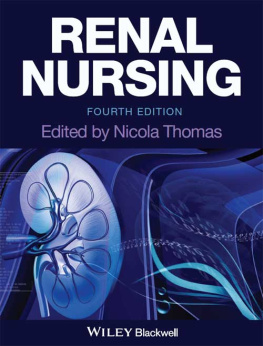
Acquisitions Editor: Crystal Taylor
Development Editors: Andrea Vosburgh and Robyn Alvarez
Editorial Coordinator: Kerry McShane
Production Project Manager: Kim Cox
Manufacturing Coordinator: Margie Orzech
Marketing Manager: Jason Oberacker
Design Coordinator: Holly McLaughlin
Prepress Vendor: Absolute Service, Inc.
Fifth Edition
Copyright 2020 Wolters Kluwer
Copyright 2014, 2010 Lippincott Williams & Wilkins, a Wolters Kluwer business.
Copyright 2007, 1994 by Lippincott Williams & Wilkins.
All rights reserved. This book is protected by copyright. No part of this book may be reproduced or transmitted in any form or by any means, including as photocopies or scanned-in or other electronic copies, or utilized by any information storage and retrieval system without written permission from the copyright owner, except for brief quotations embodied in critical articles and reviews. Materials appearing in this book prepared by individuals as part of their official duties as U.S. government employees are not covered by the above-mentioned copyright. To request permission, please contact Wolters Kluwer at Two Commerce Square, 2001 Market Street, Philadelphia, PA 19103, via email at (products and services).
9 8 7 6 5 4 3 2 1
Printed in China
Library of Congress Cataloging-in-Publication Data
Names: Rennke, Helmut G., author. | Denker, Bradley M., author.
Title: Renal pathophysiology : the essentials / Helmut G. Rennke, Bradley M. Denker.
Description: Fifth edition. | Philadelphia : Wolters Kluwer, [2020] | Includes bibliographical references and index.
Identifiers: LCCN 2018054070 | ISBN 9781975109592 (paperback)
Subjects: | MESH: Kidney Diseasesphysiopathology | Kidneyphysiopathology
Classification: LCC RC903.9 | NLM WJ 300 | DDC 616.6/107dc23 LC record
available at https://lccn.loc.gov/2018054070
This work is provided as is, and the publisher disclaims any and all warranties, express or implied, including any warranties as to accuracy, comprehensiveness, or currency of the content of this work.
This work is no substitute for individual patient assessment based upon healthcare professionals examination of each patient and consideration of, among other things, age, weight, gender, current or prior medical conditions, medication history, laboratory data, and other factors unique to the patient. The publisher does not provide medical advice or guidance, and this work is merely a reference tool. Healthcare professionals, and not the publisher, are solely responsible for the use of this work including all medical judgments and for any resulting diagnosis and treatments.
Given continuous, rapid advances in medical science and health information, independent professional verification of medical diagnoses, indications, appropriate pharmaceutical selections and dosages, and treatment options should be made, and healthcare professionals should consult a variety of sources. When prescribing medication, healthcare professionals are advised to consult the product information sheet (the manufacturers package insert) accompanying each drug to verify, among other things, conditions of use, warnings, and side effects and identify any changes in dosage schedule or contraindications, particularly if the medication to be administered is new, infrequently used, or has a narrow therapeutic range. To the maximum extent permitted under applicable law, no responsibility is assumed by the publisher for any injury and/or damage to persons or property, as a matter of products liability, negligence law or otherwise, or from any reference to or use by any person of this work.
shop.lww.com
To our families, Stephanie and Christianne Mary, Brendan, Jennifer, and Mackenzie

In this fifth edition of Renal Pathophysiology: The Essentials , we have maintained the general principles that guided us in the design and approach of the last four editions of the book. Over these last years, we have received many comments and suggestions not only from our second-year medical students but also from house staff, nephrology fellows, and colleagues; we are most grateful for their feedback and encouraging words. As a consequence of these suggestions, we have further expanded the sections on molecular aspects of the mechanisms that result in kidney dysfunction and the morphologic expression of the major diseases that affect the kidney; the illustrations are in full color and inserted into the text. The list of suggested readings has been updated and summaries are included at the end of physiology chapters. We have also reviewed supplemental self-examination questions that permit application of key concepts to clinical cases and to develop more nuanced understanding. However, the core and the principal aim of this book remain unchanged: to provide the student with a solid understanding of the mechanisms that result in kidney dysfunction and disease and to serve as the basic reading material and text for a course in kidney pathophysiology.
HGR AND BMD
OBJECTIVES |
By the end of this chapter, you should have an understanding of each of the following issues:  The general mechanisms by which solute reabsorption and secretion occur in the different nephron segments. The general mechanisms by which solute reabsorption and secretion occur in the different nephron segments.
 The factors regulating the glomerular filtration rate. The factors regulating the glomerular filtration rate.
 The mechanisms by which the glomerular filtration rate is measured in patients. The mechanisms by which the glomerular filtration rate is measured in patients.
|
Although readers of this book should have already completed a course on normal renal physiology, a brief review of the basic principles involved is helpful in understanding the mechanisms by which disease might occur. Tubular functions are discussed with a major emphasis on sodium and water reabsorption. The glomerular filtration rate (GFR) including its regulation and how it is estimated in the clinical setting are also reviewed.
The kidney performs two major functions:
 It participates in the maintenance of a relatively constant extracellular environment that is necessary for the cells (and organism) to function normally. This is achieved by excretion of some waste products of metabolism (such as urea, creatinine, and uric acid) and of water and electrolytes that are derived primarily from dietary intake. Balance is a key principle in understanding renal functions. Balance , or steady state , is maintained by keeping the rate of excretion equal to the sum of net intake plus endogenous production:
It participates in the maintenance of a relatively constant extracellular environment that is necessary for the cells (and organism) to function normally. This is achieved by excretion of some waste products of metabolism (such as urea, creatinine, and uric acid) and of water and electrolytes that are derived primarily from dietary intake. Balance is a key principle in understanding renal functions. Balance , or steady state , is maintained by keeping the rate of excretion equal to the sum of net intake plus endogenous production:
Excretion = Net Intake + Endogenous production
Net intake is the excess substance remaining in the body after meeting metabolic needs. As will be seen, the kidney is able to individually regulate the excretion of water and solutes (such as sodium, potassium, and hydrogen) largely by changes in tubular reabsorption or secretion. If, for example, sodium intake is increased, the excess sodium can be excreted without requiring alterations in the excretion of water or other electrolytes.
 It secretes hormones that participate in the regulation of systemic and renal hemodynamics (renin, angiotensin II, and prostaglandins), red cell production (erythropoietin), and mineral metabolism (calcitriol [1,25-OH dihydroxy vitamin D], the major active metabolite of vitamin D).
It secretes hormones that participate in the regulation of systemic and renal hemodynamics (renin, angiotensin II, and prostaglandins), red cell production (erythropoietin), and mineral metabolism (calcitriol [1,25-OH dihydroxy vitamin D], the major active metabolite of vitamin D).
Next page







 The general mechanisms by which solute reabsorption and secretion occur in the different nephron segments.
The general mechanisms by which solute reabsorption and secretion occur in the different nephron segments. It participates in the maintenance of a relatively constant extracellular environment that is necessary for the cells (and organism) to function normally. This is achieved by excretion of some waste products of metabolism (such as urea, creatinine, and uric acid) and of water and electrolytes that are derived primarily from dietary intake. Balance is a key principle in understanding renal functions. Balance , or steady state , is maintained by keeping the rate of excretion equal to the sum of net intake plus endogenous production:
It participates in the maintenance of a relatively constant extracellular environment that is necessary for the cells (and organism) to function normally. This is achieved by excretion of some waste products of metabolism (such as urea, creatinine, and uric acid) and of water and electrolytes that are derived primarily from dietary intake. Balance is a key principle in understanding renal functions. Balance , or steady state , is maintained by keeping the rate of excretion equal to the sum of net intake plus endogenous production: